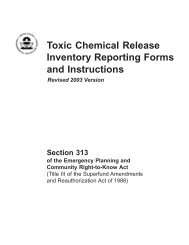(Lockout/Tagout) (revised 2002) OSHA 3120 - Seton
(Lockout/Tagout) (revised 2002) OSHA 3120 - Seton
(Lockout/Tagout) (revised 2002) OSHA 3120 - Seton
You also want an ePaper? Increase the reach of your titles
YUMPU automatically turns print PDFs into web optimized ePapers that Google loves.
employees to follow an established procedure to ensure that<br />
machinery will not be reenergized until the same employee<br />
who placed the lockout device on the energy-isolating device<br />
removes it.<br />
How can I determine if the energy-isolating device<br />
can be locked out?<br />
An energy-isolating device is considered “capable of being<br />
locked out” if it meets one of the following requirements:<br />
• Is designed with a hasp or other part to which you can<br />
attach a lock such as a lockable electric disconnect switch;<br />
• Has a locking mechanism built into it; or<br />
• Can be locked without dismantling, rebuilding, or replacing<br />
the energy-isolating device or permanently altering its<br />
energy-control capability, such as a lockable valve cover<br />
or circuit breaker blockout.<br />
What do I do if I cannot lock out the equipment?<br />
Sometimes it is not possible to lock out the energy-isolating<br />
device associated with the machinery. In that case, you must<br />
securely fasten a tagout device as close as safely possible to the<br />
energy-isolating device in a position where it will be immediately<br />
obvious to anyone attempting to operate the device. You also<br />
must meet all of the tagout provisions of the standard. The tag<br />
alerts employees to the hazard of reenergization and states that<br />
employees may not operate the machinery to which it is attached<br />
until the tag is removed in accordance with an established<br />
procedure.<br />
10<br />
Control of Hazardous Energy (<strong>Lockout</strong>/<strong>Tagout</strong>)
















